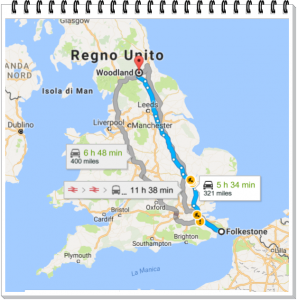From French Fleas to English Horses
When eventually came out from the Eurotunnel I was disappointed: there was nothing special. Of course I was in Folkestone, England, but there was nothing welcoming us: we were simply sent away our train and met no special buildings, nothing but for an anonymous road leading us to more trafficked one. I already wrote about driving in England, to The North, and you can read my impressions here, I love that sign by the way! Today, I will concentrate on what happened in around Stanstead Airport, I think it was there, mile more or mile less, I remember planes flying low over my head.
While waiting for my train, at the Eurotunnel, I noticed some dark brown dots among Briony hair. “Unfortunately”, I have been a parasitology intern for a whole semester, which means I know more than I wish to know about all sort of nasty bugs infesting pets. The combination black dots + dog + hair, therefore, elicited quite an alarming reaction, but I desperately tried to be positive. Briony had been bathed, cleaned and groomed before I left, to make sure she was not going to travel around Europe carrying any clandestine bugs. She hardly had any parasites during all her life and I am quite picky in these things, I really had no reason to fear the worst. My inquisitive mind, however, was looking for detailed answers. It was afternoon when I decided to stop at a service station: my sat nav told me that there was one (and road signs said the same) so I followed their advice and I got lost. I know it might sound stupid, but in Italy motorway’ service stations are ON the motorway, not elsewhere. Since you pay to access the motorway here, you are not supposed to leave it until your trip is over: they basically lock you inside, together with everything you might need. You do not need to leave the motorway to buy some food, or some gas. So, as naïve as I can sometimes be, I could not believe my sat nav was taking me away from the motorway. I ended up in a small village, at a small village Country Club to be more precise, very pretty but no service stations. I stopped the car in a corner, recollected myself and persisted, eventually landing in a giant parking lot surrounded by supermarkets of all sorts. I badly needed a toilet (I drank so much water on the way!), something fresh to drink and a dinner for the night but… it was incredibly hot, too hot to leave the dog in the car for a prolonged time. I ended up leaving the car semi-open and having multiple- short- trips the shops.
After the first trip – toilet -I went back to the car, took Briony out, walked her and then dug among bags and suitcases to find the “grooming bag” and the medicines case. Flea comb came out first confirming my fears: the dog was carrying hundreds of bugs. I could not believe it: she was bug free when we left from home and now she was covered with fleas! I do not like chemicals and I know the less toxic products against fleas are not 100% effective but, I had to do something! I decided to adopt a multi-step strategy: part first consisted in looking for any single bug and smashing it, to be sure of its death. It took more than an hour… I then took Frontline spray, Neem spray and Scalibor collar (I travel heavy for a reason!) and placed all of them (these molecules can be safely used together) on Briony… I am an holistic vet in progress, I try to avoid medicines and chemicals at all costs, but I was so shocked by all those fleas that I opted for heavy artillery! I did not want to carry all those fleas around much longer.
As soon as she looked cleaner, I sprayed Frontline inside the crate and inside the car and left, in the hope to reach Woodland, in County Durham, my final destination, before the sunset. I think I parked in my B&B yard at around 9 PM, it was the golden hour and the place looked peaceful and welcoming. The owners were as well, I immediately loved that small “farm” with stone walls, surrounded by horses and paddocks, an ideal temporary home! (Slideshow with pictures below).
Ps. If you wonder where did the fleas came from… I think they were a gift from some French cats roaming around the French hotel…
Still curious about British trials? Check the section A Month on the Moor or click here.





